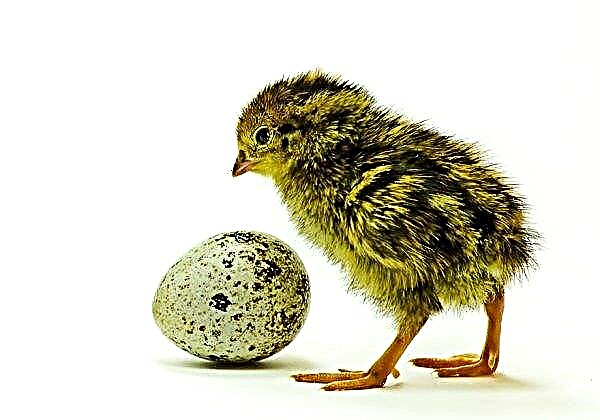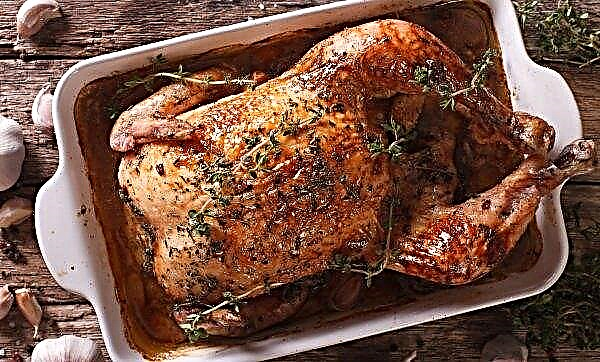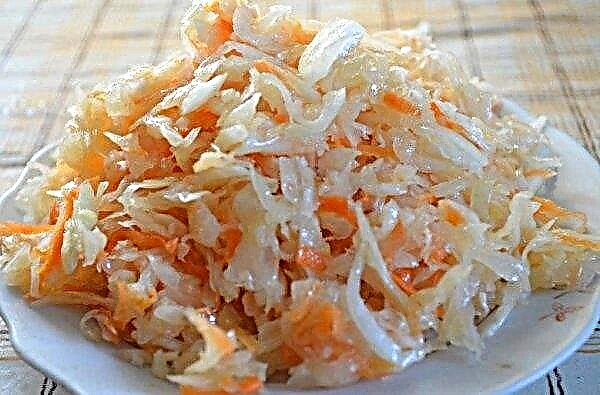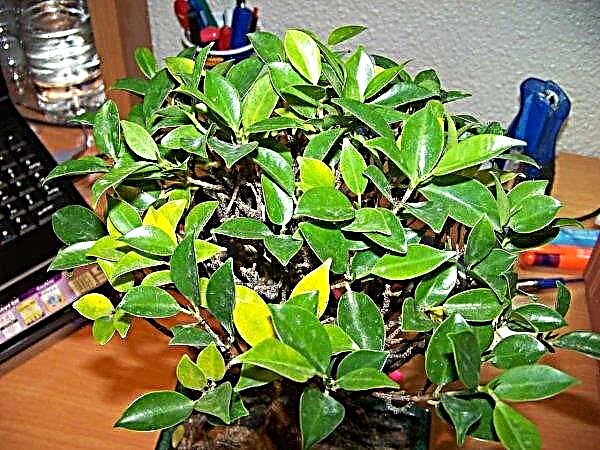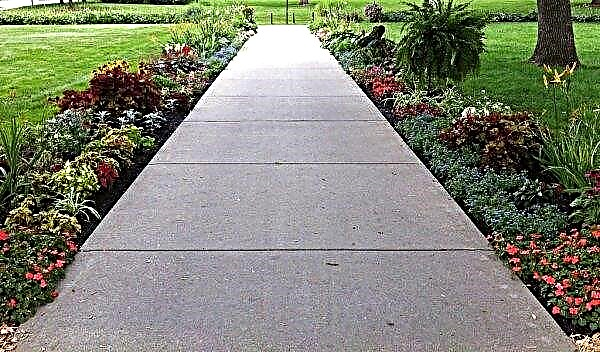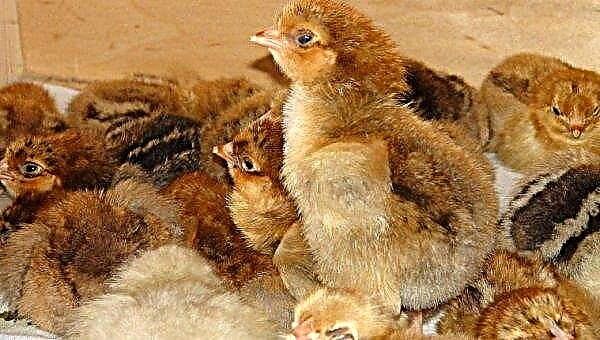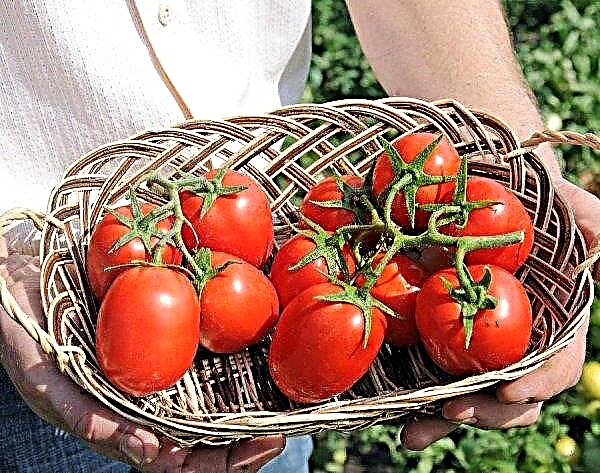Norway spruce Medusa (Picea abies Medusa) on a stem is a wonderful ornamental plant. Its original appearance will not leave indifferent both experienced gardeners and people far from botany. Indeed, one does not need to be a specialist to appreciate these unusual conifers - despite their small stature, in a small garden they are the first to attract attention.
Botanical tree description
A miniature coniferous tree, which by the eleventh year of life barely reaches a height of 30–32 cm, and 40–43 cm in diameter. Although the height of the spruce, when grown on a stem, is more dependent on the place of vaccination, and can reach 1 meter or more. Annual growth does not exceed 2–4 cm. The crown of the plant has a flattened, pillow-like shape. Outwardly, it is very similar to the Pusch variety, but differs from the latter in branches of greater stiffness and shorter length.
The needles grow to 1 cm, the traditional green color, which can not be said about the cones: they appear in the spring, at first they have a purple color, and only after a while they become brownish with a purple hue. Winter hardiness, as for such a small plant, is very decent: the spruce can withstand frosts down to -35 ° C. A tree lives up to 50-60 years.
Did you know? One of the ancestors of Medusa, as well as Push and some other varieties, is Acrocon spruce, which was bred in Finland in 1890. These lands belonged to the Russian Empire then, so it can be argued that Medusa has Russian roots.
Landing
Picea abies Medusa loves places well-lit by the sun, cool soil with moderate moisture and good water conductivity. The most acceptable soil type is sandy loam or loam, with a pH of 5.0–6.0. Based on these criteria, you should select a site for planting.
The most suitable time for planting is early spring or the second half of autumn. The place for the plant should be selected in advance, in addition to the specified criteria, it is desirable that the groundwater does not come close to the surface. In this case, the shallow roots of the plant may suffer.

2-3 weeks before the planned landing date, you must perform the following procedures:
- Dig out pits 60–70 cm deep and of the same width. The distance between adjacent plants should be at least two meters.
- Cover the bottom of each well with a layer of drainage (20 cm). You can take chipped tiles or bricks, pebbles, river sand. A mixture of the substances listed above, in arbitrary proportions, proved to be very good.
- Prepare a substrate of clay, sand, humus and peat (2: 1: 3: 1), mix well. Pour a layer of rotted spruce sawdust onto the drainage, lay the prepared soil mixture on top, so that the root neck of the seedling placed on the embankment is 1-2 cm above the ground.
- Pit with laid drainage and embankment, shed with boiling water with potassium permanganate (1 tsp. In a bucket of water in one hole).
Seedlings are best purchased at a nursery specializing in these plants. Such establishments usually value their reputation and sell high-quality planting material. Saplings are bought by the age of 3-4 years, usually in special farms they sell just such trees on stambams, 50–70 cm high, in pots. The needles of the plant should have a shiny appearance, without traces of dryness.
Important! Spruce Medusa on the stem very sharply reacts to dry air, soil and poor ecology, so it can rarely be seen in the city.
The landing procedure is carried out in the following order:
- Dip the root system of the seedling for 10-15 minutes in a solution of "heteroauxin."
- Place the plant on the constructed embankment so that the root neck is just above the ground.
- Fill the hole with the prepared substrate, slightly tamping it. Within a radius of 50-60 cm from the trunk, make an earthen rampart 10-15 cm high in a circle. This will be a near-stem circle for irrigation.
- Pour the plant with two buckets of warm water, in one of which dissolve 8 tbsp. "Nitroammofoski" and 2 hours of funds "Kornevin."
- Mulch the circle with peat mixed with coniferous sawdust in equal shares. On top of the mulch pour a thin layer of pine bark.

Spruce care
The procedures for caring for the Medusa are quite simple and do not require highly qualified gardener or extensive experience in this industry. It should be said that this species generally has fairly moderate needs and is unpretentious. The main thing is to follow the recommendations described below and do everything on time.
Stamping
Inoculation of the crown of one plant (scion) on the trunk of another (stock) is called stamping. Cultures must be of the same genus or species, compatible. And genetically scion should be stronger than stock. For any Christmas trees, including dwarf trees, the best stock is the trunk of the Spruce ordinary.
There are several different ways to get vaccinated:
- cambium (educational tissue of roots and stems) or core to cambium;
- side cleavage;
- in the upper kidney.

We will tell you more about vaccination in the last way:
- First of all, you should get a stock - ordinary spruce, the trunk of which will serve as a mushroom. The procedure is no different from the usual cultivation of conifers to a certain height.
- When the stock reaches the growth you need (50–70 cm and above), a Medusa stalk with 3-4 live strong buds is grafted to it. It is better to be vaccinated in April.
- As a scion, you should take a shoot 1-2 years old, the thickness of which is slightly less than the diameter of the stock. On the selected handle, it is necessary to leave only the upper needles, which are located at the end of the branch. Remove the remaining needles with a knife to reduce the loss of moisture (otherwise it may dry out before it is taken).
- Above the top rootstock bud you need to make a wedge-shaped cut. And sharpen the heel of the cut branch like a pencil.
- Insert the shank with a pointed end evenly and gently into the slice of the stem (also previously treated with a growth stimulator), combining the cambium at least on one side. The whole operation should be carried out as quickly as possible. The junction should be treated with garden varieties and wrapped with foil.

If the whole procedure is performed correctly, after about 4-5 weeks, the graft should take root, and the kidneys begin to swell on it. Young shoots will then grow from them. As it appears, the new shoots will need to be pinched, and after a couple of seasons, the spruce on the trunk will have a completely decorative look. This is not to say that the stamping procedure is extremely complex; rather, it requires patience and accuracy.
Important! When harvesting scion and processing rootstock, use only a sharp garden knife. Secateurs or scissors can not be used, as they injure plant tissue, which can adversely affect the successful outcome of the operation.
Watering and feeding
A tree needs regular and fairly plentiful watering, but soil cannot be flooded. Including due to the surface location of the root system, which holds the tree worse in water-softened soil. In addition, moisture retention in the root zone can provoke the development of fungal diseases.
The irrigation rate during the period with the usual amount of natural rainfall is about 1 bucket in 7-10 days. During drought, the frequency of irrigation increases 2-3 times. The plant responds well to fertilizer application.

During the season (from spring to late autumn), Medusa is usually fed 3 times, according to this scheme:
- beginning of spring (every second year) - rotted cow manure, pigeon or chicken droppings (0.5 l / 1 bucket of water, per spruce);
- May-June - universal dressings for conifers, for example, Kemira Universal (3 tbsp. l / 1 m²), or very little nitric fertilizer of the nitrate group (1 tbsp potassium, magnesium or calcium nitrate per 1 m² one-time).
- July – September - magnesium, potassium and phosphorus (in accordance with the instructions for the tool);
- the last top dressing (preparation for winter) is superphosphate (2 tbsp. l / tree).
If the spruce was adequately fed during planting, the next time fertilizers are applied after a year.
Important! Nitrogen fertilizers, in such quantities as deciduous, conifers, are not needed - because the needles do not fall, and the tree does not need to gain green mass. After June, it is not recommended to introduce them at all, since abundantly growing shoots may not have time to get stronger before the onset of frost, which will lead to their death.
Loosening and mulching
To loosen Medusa is necessary after each watering. The procedure is necessary for normal root breathing. It should be done very carefully, in order to avoid damage to the roots. When loosening, do not disturb the soil layer deeper than 6-8 cm. The plant should be mulched regularly. Firstly, the mulch does not allow the soil to dry out, and secondly, it prevents the growth of weed grass. In addition, it is an excellent means of warming plants for the winter.
For this procedure, it is best to use a mixture of peat and pine sawdust, however, if these components are not available, dry needles are also suitable. Particularly responsible should be mulching before wintering young plants. To do this, lay a fresh mulching pillow, and cover it with pine lapnik on top.

In the future, when the tree takes root in a new place and grows up, it will be enough to cover only the trunk circle for the winter. Although in the southern regions you can do without it at all, it is still better to mulch the area around the tree, since in addition to heating, this measure contributes to the normal growth of the tree and has a beneficial effect on the soil condition.
Pruning
Spruce Medusa is a plant exclusively decorative, it needs not only sanitary scraps, but also forming ones. There is a point of view that the procedures for shaping this variety are necessary to a minimum. The argumentation of this position is as follows: the plant is already exotic, has a beautiful original appearance, and it only occasionally needs to remove extra branches that are knocked out of the crown.
Did you know? In fires, tree cones explode, resulting in seeds scattering 35-40 m. However, this method of planting offspring has a significant drawback - along with smoldering cones, fire spreads through the forest.
Perhaps this position is not meaningless, in any case, the forming trim should be performed in the spring, before the buds open. The first time such a procedure is performed shortly after landing at a new place. As for sanitary pruning, in any case, it is carried out in early spring, removing all frozen and dry branches. Places of cuts are covered with garden varnish, or treated with Bordeaux liquid.

Possible diseases and pests
The spruce immunity is well developed, the plant is quite resistant to diseases and pests. As for most coniferous crops, perhaps only fungal diseases can be a danger to Medusa. They arise and develop most often due to violation of sanitary standards, dense plantings, excessive watering.
Signs that something is wrong with your tree is as follows:
- the tops of the shoots are covered with white, gray or brownish coating;
- the appearance of mold on needles;
- the needles turned brown and began to dry.

If you find one or several of these symptoms on a plant, it's time to take action:
- Cut sick and dried shoots, destroy them away from the garden.
- The places of cuts should be covered with garden var. Sick spruce and all plants nearby, as well as the soil nearby, should be treated with fungicidal preparations such as Bordeaux liquid, "Abiga-Peak", "HOM", etc.
Coniferous pests infrequently. However, if this does happen, treat Medusa with insecticides (Karbofos, Aktellik, Chlorofos), as indicated in the instructions. Processing is carried out mainly closer to the middle of summer, twice, with a difference of 15–20 days.
Did you know? On the ground, 21 plants are officially registered that were born before 500 AD. Of these trees, 20 belong to the coniferous family, and only one deciduous — Ficus sacred.
The use of wood in landscape design
Norway spruce Medusa - a plant that provides almost limitless options for use in landscape design. More precisely, the area of its use can be limited only by your imagination.
Here are just some of the options for elements and compositions where a tree can be involved:
- alpine hill;
- small Japanese garden;
- container plant, which can be rearranged from time to time, for a change, and brought into the house for the winter;
- heather garden;
- retaining wall;
- as the foreground of deep compositions;
- in a circular planting framing a higher coniferous plant (cypress, fir, thuja).

Looks great among pebbles of uniform gray color. Thus, you can decorate the space between the pots with plants installed in the garden, or make decorative elements from this material around the fir trees growing in the ground.
Despite its decorativeness, Medusa is quite unpretentious in care. Its advantages should also include an original and very beautiful appearance, compact size and the widest possibilities for use in decorative landscaping. The only significant minus of the variety is its price - quality seedlings from the nursery cost from 4 thousand rubles apiece.

